Reports
Shock Wave Generator for Iran’s Nuclear Weapons Program: More than a Feasibility Study
by David Albright and Olli Heinonen**
May 7, 2019
The Iranian Nuclear Archive reveals that under its early 2000s nuclear weapons program known as the “Amad Plan,” Iran was developing and manufacturing a key nuclear weapon subcomponent called a “shock wave generator.” The shock wave generator is a multi-point initiation (MPI) system, which has the purpose of uniformly initiating a spherical shell of high explosives, or the “main charge,” which in turn compresses the nuclear core made from weapon-grade uranium to achieve a supercritical mass for a nuclear explosion. Iran’s Nuclear Archive, a significant portion of which Israel seized in January 2018, is a curated set of highly sensitive nuclear weapons information detailing the Amad program’s effort to develop and manufacture five nuclear weapons and prepare an underground nuclear test site for possible use.
The development of the shock wave generator, also known as distributor, contributed importantly to Iran’s miniaturization of a nuclear weapons design.
A key associated Amad Plan facility was near the village of Sanjarian, called the “Sanjarian facility.” It made high explosive parts for the shock wave generator and conducted a range of tests for its development. In addition, under the Amad Plan, it was a center for the testing of exploding bridgewires (EBWs), which were necessary for the shock wave generator. Its nuclear weapon-related activities after the Amad Plan remain to be determined.
The Sanjarian building held two blast chambers, called Upper and Lower Nour-Abad, which were used in the Amad Plan, and perhaps afterwards, to test EBWs, the shock wave generator, and other subcomponents. One chamber was outfitted with a high speed camera. A full-scale, hemispherical test of the shock wave generator, using sophisticated diagnostic equipment, was conducted at the Marivan site, according to the archive information.
The archive contains considerably more information about the shock wave generator and Iran’s nuclear weapons development and testing than can be presented in this report. That information – due to proliferation reasons – cannot be made public.
The archive indicates that Iran had completed almost two thirds of the tasks associated with the “Shock Generator Project” by around 2002. With an expected completion date of July 2003, Iran may have completed the additional, approximately third of the tasks just before the Amad Plan was downsized and reoriented in the fall of 2003. The exact status of this project at that time and its evolution after the fall of 2003 remains to be determined.
Foreign assistance from at least one former member of the Soviet nuclear weapons program was key to Iran’s development of this MPI technology.
Preserving these complex nuclear weapons capabilities was a priority for Iran in the post-Amad reorientation plan. After 2003, the Shock Generator Project activities and Sanjarian facility were provided with a cover purpose of performing non-nuclear military and non-military explosive tests, and some activities were shifted to universities, such as Malek Ashtar University of Technology, and research institutes. Iran prioritized maintaining the project’s workforce. The status of these activities is unknown today, but the archive information indicates that they may continue. The Organization of Defensive Innovation and Research (SPND) is the latest known incarnation of the reoriented Amad Plan that appears to have inherited the personnel and capabilities of the Shock Generator Project.
The archive information on the shock wave generator confirms and adds considerably to previous information on this MPI system assembled over a decade ago by the International Atomic Energy Agency (IAEA).
The IAEA needs to inspect the Sanjarian site and related facilities, examine relevant equipment and materials, and interview the personnel mentioned in the archive and from the IAEA’s previous, extensive work to understand the shock wave generator project. The IAEA needs to characterize the status of the program today, its work and associated equipment, and interview any related personnel.
Iran should be urged to cooperate fully in these investigations. In particular, no information or equipment should be destroyed, and no locations altered before the IAEA has completed its investigations. Those investigations should include weapons experts with proper clearances. At the end of the inspection process, proliferation-sensitive information and equipment, where on-going possession is not in line with Iran’s undertakings under Article II of the Nuclear Non-Proliferation Treaty (NPT), should be destroyed irretrievably or removed from Iran in a verifiable manner.
Shock Wave Generator
Iran was developing and building a nuclear weapons production complex in the early 2000s under the “Amad Plan,” with the goal of manufacturing five nuclear weapons by 2004. This program had moved beyond performing feasibility and scientific studies. Iran had a nuclear weapons design small enough to fit on the Shahab-3 ballistic missile and was creating the wherewithal to develop and make the subcomponents of that design. Some of the components were innovative and complex. The primary subject of this report is one of those subcomponents, the “shock wave generator.”1 This component, which is represented as the green layer under the outer casing in the nuclear explosive schematic (Figure 1), contributed importantly to the miniaturization of Iran’s nuclear weapon design. Its purpose is to uniformly initiate the high explosives, or “main charge,” which in turn compress the nuclear core made from weapon-grade uranium to achieve a supercritical mass and a nuclear explosion. This component falls under the general category of a multi-point initiation (MPI) system.
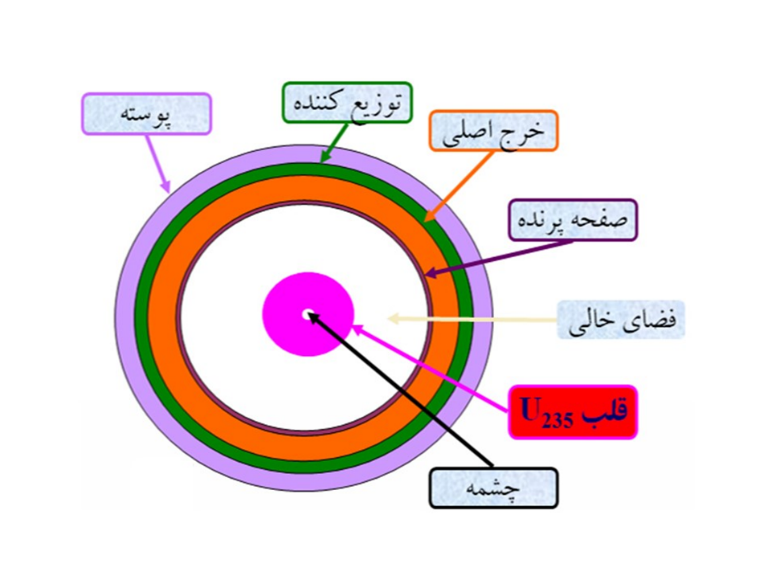
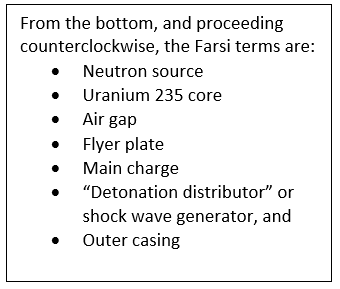
Figure 1. A schematic of a levitated nuclear weapon design, e.g. one with an air gap and flyer plate to increase compression of the core, based on the use of weapon-grade uranium, from the Nuclear Archive and presented by Prime Minister Benjamin Netanyahu on April 30, 2018.
The Nuclear Archive contains important information about the shock wave generator which confirms and adds to previously available information, in particular, information assembled by the IAEA about a decade ago. This report also takes into consideration detailed, public reporting on the Iranian shock wave generator from the period of about 2008 to 2011.
A key development and manufacturing facility associated with the shock wave generator was located near the village of Sanjarian, also known as Sanjarion or Sanjarioun, located about 20 kilometers east of Tehran and about 15 kilometers north-northeast of the high explosive test chamber complex at the Parchin site. The Sanjarian site and its general significance relative to nuclear weapons detonator development was previously identified publicly,2 but the archive adds important confirmation and considerable detail to that earlier reporting.
The archive provides the first public indication of the priority Iran attached to preserving its capability to make a shock wave generator and the associated Sanjarian facility during the downsizing and reorienting of the Amad Plan in late 2003. Their current status is unknown, but the archive information indicates that these capabilities may be active today.
Shock Wave Generator’s Place in Overall Amad Plan Organization
The development and manufacture of the shock wave generator took place under the Amad Plan, Iran’s military nuclear program in the early 2000s composed of many projects needed to make, at least initially, five nuclear weapons and prepare a nuclear test site. In particular, in the archive documents, what is called the “Shock Generator Project” was under the nuclear weaponization portion of a project codenamed Project 110, which was composed of four main technical subprojects. The chart in Figure 2, which is an early Project 110 organizational chart from the archive, shows the four main technical projects, also listed here:
Operating System Project
Midan Project
Simulation Project
Warhead Project
As can be seen in the chart (Figure 2), the Shock Generator Project is listed under the Operating System Project, which was charged with the task of creating a complex to develop and build nuclear weapons. As explained in a separate Institute/FDD report, the Midan Project was responsible for creating a nuclear test site for a 10 kiloton detonation and methods to estimate the yield of a nuclear detonation.3 As far as can be understood based on currently available information, the Simulation Project was involved in theoretical and software aspects of developing and manufacturing nuclear weapons, and the Warhead Project was charged with fitting the nuclear warhead into the re-entry vehicle of a Shahab-3 ballistic missile, including fusing, arming, and firing mechanisms.
Based on an Amad Plan table prepared in about 2002 (not shown here), the start date of Project 110 was March 20, 2000, and the expected completion date was given as four years later, on March 17, 2004. This table lists the start date for the Shock Generator Project as May 15, 2000, with a completion date of July 20, 2003, making it a three-year project. It should be noted that its completion date is eight months before the overall target completion date for Project 110, which aimed to have finished building five nuclear weapons by March 2004. An earlier completion date for the Shock Generator Project would be expected, since the subcomponents of Project 110 would need to be produced before the first nuclear weapon would be assembled.
As of the date of the 2002 table referenced above, the Shock Generator Project had completed 58 percent of its tasks, versus 64 percent expected to be completed by this time. Although somewhat behind schedule, the project appears to have been making steady progress, finishing almost two thirds of its tasks in about two years. Completing the last 40 percent of the remaining tasks in its final year could have been possible.

Figure 2. Translation of a Nuclear Archive chart depicting the organizational structure of Project 110, showing the Shock Generator Subproject. Commissioner can also be translated as commander. The extra white lines on the mid-left of the chart are from the original diagram.
As discussed in previous Institute/FDD reports, due to international pressure and scrutiny, the Amad Plan was downsized and reoriented in the fall of 2003. Given the expected July 2003 completion date of the Shock Generator Project, prior to the decision to downsize and reorient the nuclear weapons program, it may be that Iran finished its work on this important component of a nuclear weapon.
Functions of Shock Generator Project
The full extent of the Shock Generator Project cannot be described from information currently available to the Institute. Its major task will be discussed in this report – the development and manufacture of shock wave generators for use in nuclear weapons. However, the project appears to have also had some responsibility for the development and use of detonators (e.g. Exploding Bridgewires (EBWs)) and the main high explosive charge used in Iran’s planned nuclear weapon. The latter responsibility is referenced in a stacked set of four PowerPoint slides from the Iranian archive and presented by Prime Minister Benjamin Netanyahu on April 30, 2018, and subsequently provided to media. The cover slide has the title “Report of the Shock Generator Project,” and is dated November 14, 2002.
However, the stacking of the slides resulted in the covering up of portions of the text on all but the first slide, making the bottom three only partially visible. Media provided the Institute with a few versions of these slides; in one version, the underlying slides are more visible than in other versions, and could be partially read. The second slide (counting from the top one) discusses the domestic production and testing of Octol, a high explosive composed of HMX and TNT that has been used as the main charge in nuclear weapons, for example, in early U.S. nuclear weapons. It also discusses problems encountered in making Octol, such as with mixing blades.
The third slide, titled “Octol Production,” includes a discussion of signing a contract for domestic Octol production due to lack of adequate domestic production at the time. Although the name of the contractor is not given, it is likely in military industries, since Octol and its chief component, HMX, are extensively used by militaries all over the world.4 In addition, this slide discusses that foreign produced Octol was obtained and evaluated, particularly for gradation (particle size analysis), apparently as part of reverse engineering or quality control. A discussion follows on analyzing domestically produced Octol, including determining its gradation, detonation velocity, and detonation pressure. Finally, this slide reports on improving the grade of domestically-produced Octol based on the results of the testing.
The fourth slide, which is titled “Main Charge,” shows at least two hemispherical objects and an unidentified cylindrical object. It could not be determined if the hemispherical objects are mock-ups of the main charge or actual Octol main charges.
Potentially related to this effort to make an Octol main charge, Figure 3 shows an image from the archive of a high explosive hemispherical casting mold, presented in Prime Minister Netanyahu’s April 30, 2018 speech. The mold may be large enough to hold a main charge for a nuclear weapon, but an exact measurement was not attempted. After casting, a CNC machine tool was used to shape it into its final form (a hemispherical shell).
Overall, the slides suggest that the Shock Generator Project was interested in obtaining adequate amounts of Octol and assuring its quality for use in nuclear weapons. This analysis is consistent with, and confirms, the findings of IAEA nuclear experts. According to a publicly available 2009 IAEA report:5
The Agency [IAEA] assesses that Iran has managed to develop a high explosives industry capable of synthesizing and formulating the raw materials into explosive compositions and that could be used in a nuclear weapon. It is very likely that Iran has the required engineering skills to machine explosives into the weapon components.
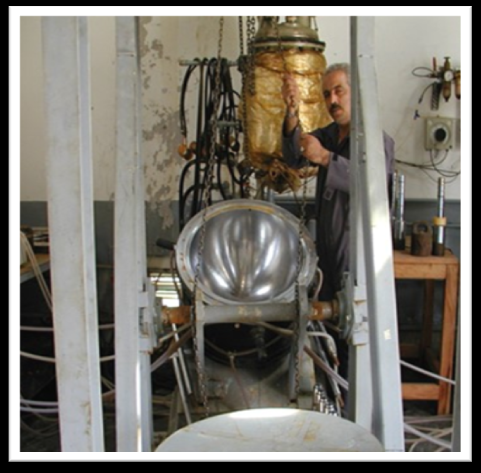
Figure 3. Image from the Nuclear Archive that shows a high explosive casting mold at an unidentified location in Iran. The equipment in the background could not be identified.
Background on the Shock Wave Generator
The shock wave generator in Project 110 is a spherical multipoint initiation system that was designed to fit inside a nuclear warhead, which in turn would be carried in the payload chamber of the Shahab-3 missile nose cone. There is considerable information about this MPI system in the public literature. The IAEA gathered significant information about this system and reported it under the names of MPI system and shock generator. The IAEA summarized its knowledge of this MPI system in its December 2015 report on outstanding issues regarding Iran’s past nuclear program.6 Much information about this Iranian MPI system also became public in the period of roughly 2008 to 2011.
The basic design of the shock wave generator is a distributed, explosive-filled channel system for initiating hemispherical high explosive charges.7 A detonation front initiated at one point via an exploding bridgewire or spark gap is made to arrive simultaneously at a multitude of points on a surface. The assembled system consists of two hemispherical shells and requires only two detonation points, which is in contrast to the 32 initiation points on the first nuclear weapons built by the United States. Moreover, this system eliminates the need to work with high explosive lenses and allows for a reduction in the size of the warhead.
In this effort, Iran appears to have had the assistance from a foreign expert knowledgeable in nuclear weapons (identified by the Institute in 2011 as Vycheslav V. Danilenko8). According to the IAEA:
Information available to the Agency in 2011 also indicated that Iran could have benefitted from the aforementioned foreign expert, who had knowledge of both MPI technology and experimental diagnostics and had worked for much of his career in the nuclear weapon programme in his country of origin. The foreign expert’s presence in Iran in the period 1996-2001 has been confirmed by Iran, although it stated that his activities were related to the production of nanodiamonds.9
U.S. and Russian patents shed light on the principles of such a MPI system. According to a 1969 U.S. patent (filed in 1963 by Richard Stresau) for the U.S. Navy:
This invention relates to explosive devices and more particularly to a new and improved surface-wave generator or detonation wave shaping system wherein a detonation front initiated at one point is made to arrive simultaneously at a plurality of points on a desired surface, the configuration of which may be either plane or curved.10
This generator in turn sets off a main charge of high explosives. The device involves a set of channels embedded within a sheet of inert elastomer, also known as an inert polymer.
This U.S. patent design from 1969, of a flat distributor with an adjacent high explosive charge, is illustrated in a 2010 book by Danilenko, whose writings are studied because of his assistance to Iran (see Figure 4).11 The distributor consists of a layer of inert elastomer with channels or grooves, which are filled with a high explosive, typically a plastic explosive, according to Danilenko. The key idea is that following detonation at one point, the length to any explosive pellet is the same, providing the simultaneity and eliminating the need for multiple detonators. Danilenko notes importantly in his 2010 book that the detonation front in the main charge initiated by the multiple explosive pellets will smooth out as it moves into the explosive charge. He adds that smoothness will be aided by increasing the number of explosive pellets, or points, e.g. decreasing the distance between the points of detonation. However, Danilenko notes that this device is complicated and labor-intensive to make.

Figure 4. Danilenko schematic of a multi-point detonation system. Translation: Figure 11.10. Multiple point initiation device. Key: 1-housing; 2-detonation separation tubes in housing grooves; 3-beginning point of separation initiation by the igniter; 4-initiating tubes in housing openings; 5-charge; 6-detonation front. Source: V.V. Danilenko, Explosion: Physics-Techniques, Technology (Energoatomizdat, 2010).
There are also at least two Russian patents on similar MPI systems with the same matrix shape as seen in the U.S. patent, although they were filed approximately 20 years after Stresau’s 1969 U.S. patent.12 It is possible that publication of these patents was delayed due to Russian classification issues. The inventers of both patents list their address at the All-Russian Scientific Research Institute for Experimental Physics, (VNIIEF), the Soviet Union’s primary nuclear weapons research and development center. At least one of the inventers, Vladimir K. Chernysev, was an important figure in the development of Soviet nuclear weapons.13
Whether similar systems were used in Russian nuclear weapons is unknown. However, the relevance of such systems for nuclear weapons was likely known in the Soviet nuclear weapons complex by the time of Stresau’s patent in the 1960s.
To better understand the MPI system made by Iran, which may have important differences from the systems in the above-mentioned patents, it is useful to review several public media and Institute reports on Iran’s multi-point initiation system derived from the above principles that were published in the period between 2008 and 2011.
In 2008, Jane’s International Defense Review wrote that Iran’s Ministry of Defense had actively pursued a “relatively advanced multipoint initiation (MPI) nuclear implosion detonation technology for some years.”14 It also reported that Iran had tested this MPI system and found it “good enough” for a nuclear weapon. A schematic in the article (Figure 5), which reportedly shows a portion of the MPI used by Iran, looks very similar to the schematic in Figure 4.
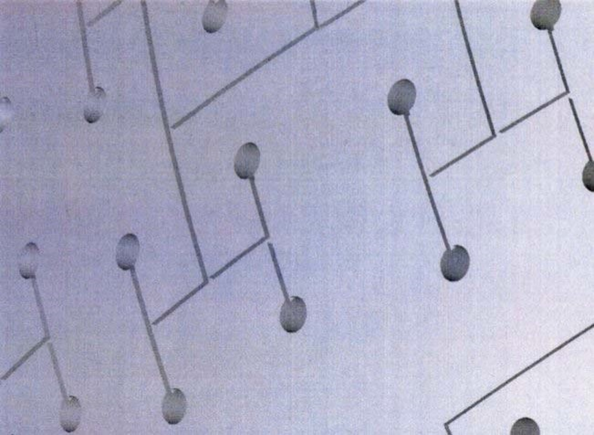
Figure 5. Schematic of a portion of the multi-point initiation system developed by Iran. Source: Jane’s.
In 2010, Paul-Anton Krüger, a reporter at the Süddeutsche Zeitung, published more detailed information on the shock wave generator, as well as on the role of Danilenko (albeit the report did not provide his real name) in aiding Iran.15 Krüger reported that the information obtained by the IAEA stated that the Iranian system was composed of two hemispheres with small milled channels and holes uniformly distributed on it and filled with high explosives. On each hemisphere, a single detonator, or exploding bridgewire, sets off the explosives in the channels, and all the small explosive charges in the holes detonate at the same time, igniting the main explosive charge under the shell.
Building on the published media work, the Institute published on this MPI system in 2011, which is summarized in the following several paragraphs.16 The information provided to the IAEA was that the shock wave generator is comprised of two hemispherical shells connected together. Media reports stated that they were made from aluminum, but this reporting may have reflected information about Iranian models of such systems. In any case, the wall-thickness of the shell was one centimeter thick. Many channels, each with dimensions of one by one millimeter, were cut into the outer surface of the shell. The channels were filled with the explosive material pentaerythritol tetranitrate (PETN), which is selected because of its moldability and stability when mixed with plasticizers. Each channel terminated in a cylindrical hole, five millimeters in diameter, that was drilled though the shell and contained an explosive pellet. The geometrical pattern formed by channels and holes were arranged in quadrants on the outer hemispheric surface, which allowed a single central point of initiation for each hemisphere and the simultaneous detonation of explosives in all the holes on the hemisphere. This in turn allows the simultaneous initiation by one EBW or spark gap of the high explosives in the main charge located under the hemispheres. EBW initiation would be preferred because Iran could make EBWs but needed to buy spark gaps, at least at that time.
In the IAEA reporting, a full-size version of the Iranian shock wave generator was referred to as the R265 generator, also called a round shock generator, where the number corresponds to the inner diameter of the shell measured in millimeters. The outer radius of the R265 system would be 275 millimeters, or an outer diameter of 550 millimeters, less than the estimated diameter of about 600 millimeters available inside the payload chamber of a Shahab-3.
Both Jane’s and Krüger reported that Iran tested this MPI system. Based on their reporting, prior to the seizure of the archive, the IAEA reportedly had information that Iran conducted a field experiment of a near or actual full-size shock generator with high explosives and a sophisticated diagnostic system, similar to one developed by Danilenko.
This information was confirmed in subsequent IAEA reporting. According to the 2015 IAEA report:
Prior to November 2011, Member States provided the Agency with information that Iran had available to it design information on the explosives technology known as multipoint initiation (MPI) and that it had used this for the initiation of high explosives in hemispherical geometry. The information indicated that Iran had developed of a hemispherical MPI system and conducted at least one large scale experiment in 2003, details of which were technically consistent, both internally and with publications authored by a certain ‘foreign expert’. The Agency has reassessed that this experiment was conducted at a location called “Marivan”, and not conducted in “the region of” Marivan [as previously reported].17
An earlier IAEA report from 2011 adds detail about Danilenko:
The Agency has strong indications that the development by Iran of the high explosives initiation system, and its development of the high speed diagnostic configuration used to monitor related experiments, were assisted by the work of a foreign expert who was not only knowledgeable in these technologies, but who, a Member State has informed the Agency, worked for much of his career with this technology in the nuclear weapon programme of the country of his origin.18
(It should be noted that the archive contains information about the Marivan site, including photos of it. The archive shows that the Marivan site undertook work linked to implosion testing. The above test would have fallen under the category of implosion testing).
According to 2011 Institute reporting, prior to the seizure of the archive, there was publicly available information about this 2003 test.19 Information from a member state, given to the IAEA several years ago, describes that in this experimental setup, which aimed to measure the time of arrival of the detonation front, 50 kilograms of Composition B explosives in the form of a shell were placed inside a hemispherical shock generator system. The time of arrival of the detonation front at the outer surface of this 50 kilograms shell of explosives was measured by using many hundreds of fiber optic cables drilled into a thin hemispherical shell or holder in close proximity of the inner surface of the explosives. The other end of each of the cables was attached to a fixture or panel. The light signals were transmitted via air to a fast-acting camera with a rotating mirror, likely a framing camera, at a safe distance from the explosion. On firing, the EBW, or spark gap, ignited the PETN explosives in the channels of the shell, setting off the explosive pellets in the holes in the shell, which in turn initiated the outer surface of the Composition B shell. The detonation front traveled through the main charge and on exiting the inner surface produced light, which was transmitted via the fiber optic cables and was captured on the film of the high speed camera.
This description with less detail is in the 2011 IAEA report:
Information provided to the Agency by the same Member State referred to in the previous paragraph [not included here] describes the multipoint initiation concept referred to above as being used by Iran in at least one large scale experiment in 2003 to initiate a high explosive charge in the form of a hemispherical shell. According to that information, during that experiment, the internal hemispherical curved surface of the high explosive charge was monitored using a large number of optical fibre cables, and the light output of the explosive upon detonation was recorded with a high speed streak camera. It should be noted that the dimensions of the initiation system and the explosives used with it were consistent with the dimensions for the new payload which, according to the alleged studies documentation, were given to the engineers who were studying how to integrate the new payload into the chamber of the Shahab 3 missile re-entry vehicle (Project 111).20
As noted above, the IAEA recognized that the diagnostic system used in this MPI test is similar to one Danilenko presented in two papers in the early 1990s at a conference on high speed photography and photonics. In their papers, Danilenko and his colleagues from the Federal Nuclear Center, the All-Russian Institute of Technical Physics (VNIITF), presented an optical technique in which fiber optic cables are used to capture the time of arrival of an explosive shock wave on a fast camera.21 VNIITF was created as a back-up facility for the All-Russian Scientific Research Institute of Experimental Physics (VNIIEF) and contained expertise in the entire spectrum of work connected with the design and development of nuclear weapons. Figure 6 has two simplified figures from one of their papers that show the basic structure of this system, illustrating it with one fiber cable. In actuality, there would be hundreds. Figure 7 shows a schematic of an experimental arrangement with emphasis on the holder and panel, along with a framing camera with a raster. A raster is a method of displaying multiple channel lines on one screen.
There is one publicly available picture from the archive that apparently shows a model of this experimental system using optical fibers (Figure 8). This model shows a hemispherical object representing the external side of the multi-point initiation system, where inside would be the high explosives and an inner surface, or holder, where the fiber optic cables would connect. The fiber optic cables exiting the hemisphere and the panel can also be seen. (The archive contains many images of actual hemispherical configurations for this type of test as well as other hemispherical high explosive tests related to developing implosion-based nuclear weapons. However, those images, in addition to a considerable amount of other information, were judged as nuclear weapons-sensitive and not made public by Israel.)
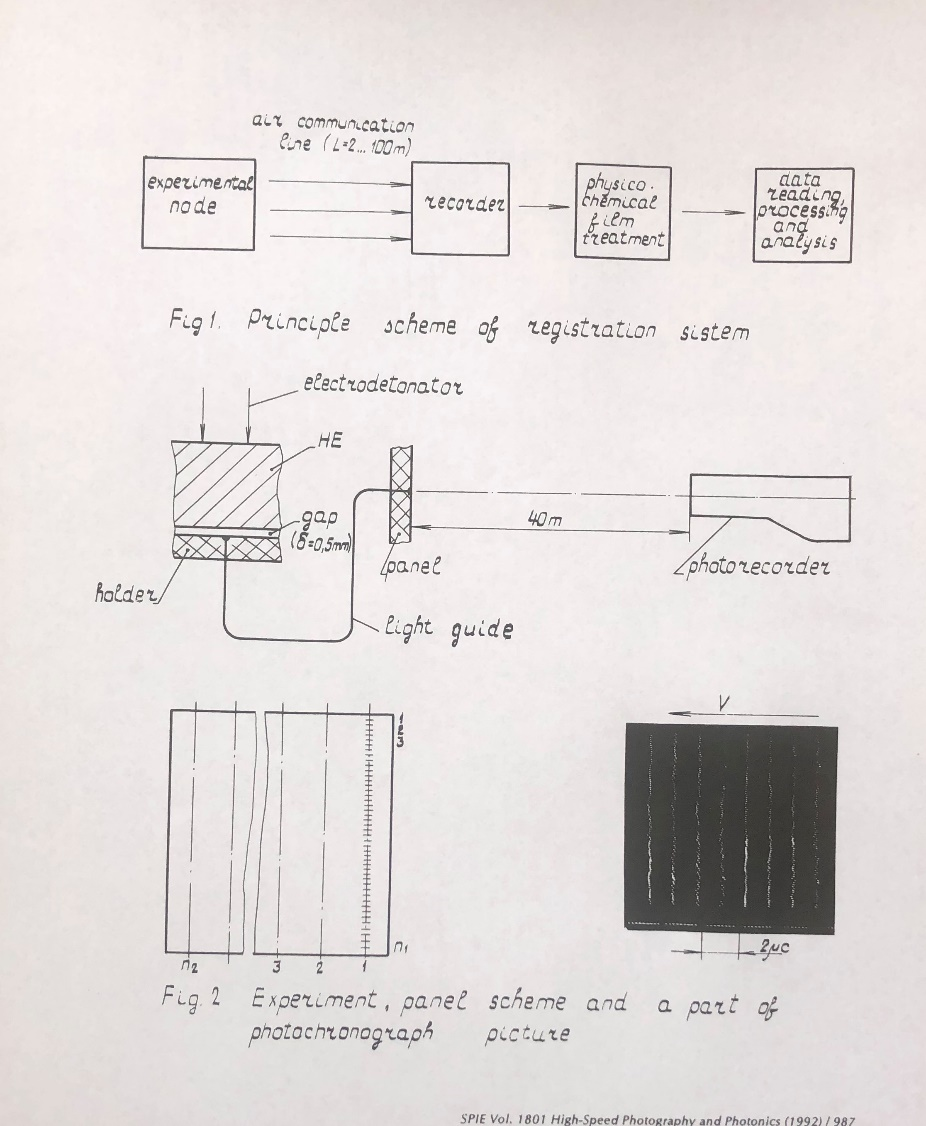
Figure 6. Schematics from Danilenko et al.’s report on a fast, fiber optic diagnostic system. “Electrodetonator” is another name for a shock wave generator. Note the lines on the photo from a raster system. As can be seen, the camera is placed at a safe distance of 40 meters from the explosion. Reprinted from: “Multichannel optical fiber system to measure time intervals in investigations of explosive phenomena.”
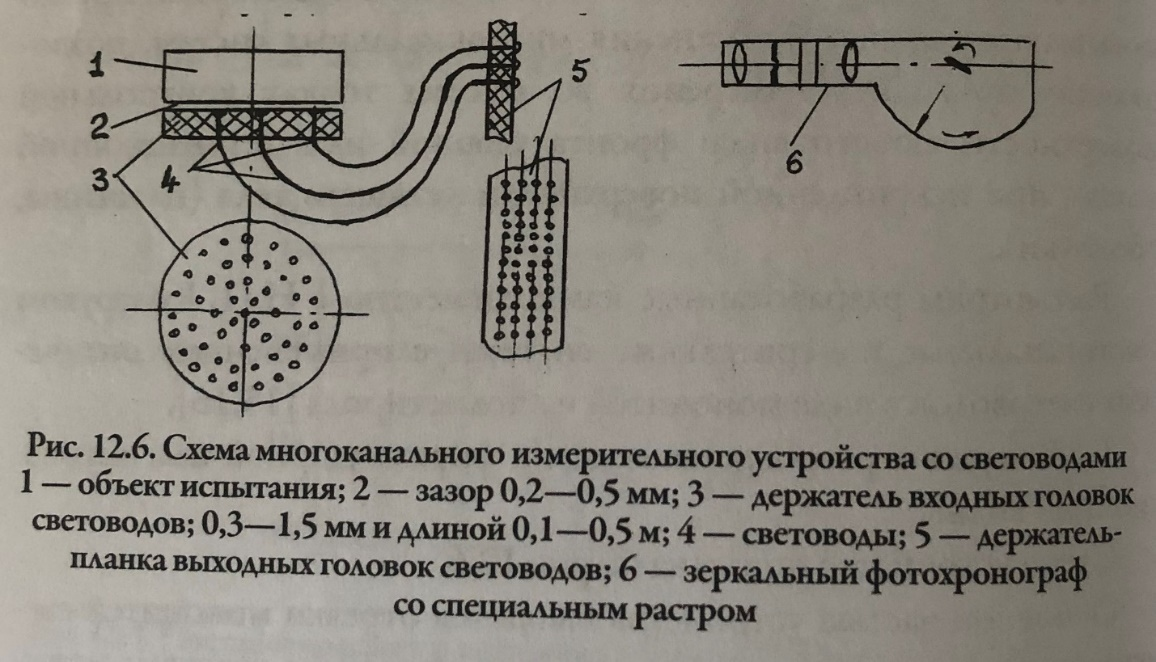
Figure 7. Multi-channel system for measuring time of arrival of a shock wave showing the holder and panel system with a framing camera with a raster.
Translation of Russian caption: Figure 12.6 Diagram of a multichannel measurement device with light guides [fiber optic cables]
1- test object; 2- 0.2-0.5 mm gap; 3- light guide inlet head holder; 0.3-1.5 mm and 0.1-0.5 m long; 4- light guides; 5- light guide outlet head strip mount; 6- mirror photo-chronograph with special raster From V.V. Danilenko, Explosion: Physics-Techniques, Technology (Energoatomizdat, 2010).

Figure 8. Model of an experimental system in the Nuclear Archive representing what appears to be a shock wave generator and high explosives, with a diagnostic system using fiber optic cables, to measure time of arrival of a detonation front in the main charge.
The Sanjarian Facility
The Nuclear Archive identifies a building at a secure site near the village of Sanjarian that was involved, during the Amad Plan, in making high explosive parts for the shock wave generator and conducting a range of tests for its development. In addition, it was a center for the testing of EBWs, which were also critical for the shock generator.
Figure 9 shows two Nuclear Archive images of the Sanjarian building. Figure 10 shows its location among a complex of buildings, and Figure 11 is a map showing its position relative to Tehran. In addition to the Sanjarian site, it is also known as the Nour-Abad site. However, as will be discussed below, this is the name used for two test chambers in the building. Figures 12 and 13 correlate the ground images to Google Earth images, establishing that the building in the image is unequivocally at the Sanjarian site and, moreover, that it was present on the first available Google Earth-hosted satellite image dated January 27, 2004.
This site was first publicly identified in 2009 by the National Council of Resistance of Iran (NCRI), which called it the “Research Center for Explosion and Impact” near Sanjarian, known under its Farsi language abbreviation METFAZ (see Figure 10). The NCRI stated that this site was developing high-explosive detonators for use in atomic bombs and manufacturing components for these detonation systems.22 The Institute was unable, at the time, to verify that such activities had occurred at the site based on the limited information available.
The NCRI added in a release in 2017 that the location was “responsible for conducting research and building a trigger for a nuclear weapon.”23 The NCRI again called the site the Center for Research and Expansion of Technologies for Explosion and Impact (Markaz-e Tahghighat va Tose’e Fanavari-e Enfejar va Zarbeh), but repeated its acronym as METFAZ. The NCRI stated in its 2017 release that its most recent investigation revealed that METFAZ had moved from the Sanjarian site and was conducting its main activities in another location, which has thus far remained secret. Nonetheless, the NCRI report did specifically state that the new location was at the Parchin military complex and was given the codename “Research Academy” (Pazhouheshkadeh). The NCRI added, “this location has become the main center for METFAZ’s tests and other activities. Following the Joint Comprehensive Plan of Action (JCPOA) in 2015, in order to avoid blowing the cover on METFAZ’s activities, a large portion of the activities conducted at METFAZ in Sanjarian, as well as the personnel working at the site, were transferred to the Research Academy situated within Parchin. The move resulted in the subsiding of activities at the Sanjarian site.”24 Although the Institute could not corroborate the specific allegations by the NCRI using commercial satellite imagery, it was able to confirm via satellite imagery analysis that the NCRI identified site at Parchin is a high explosives research and development and manufacturing site. Subsequent Google Earth satellite images of the Sanjarian facility, which were recently scrutinized by the Institute, do indicate that the facility looks less well maintained than in earlier years, which is at least suggestive that the original role of the facility, namely to develop and manufacture shock wave generators, has changed, consistent with the NCRI reporting.
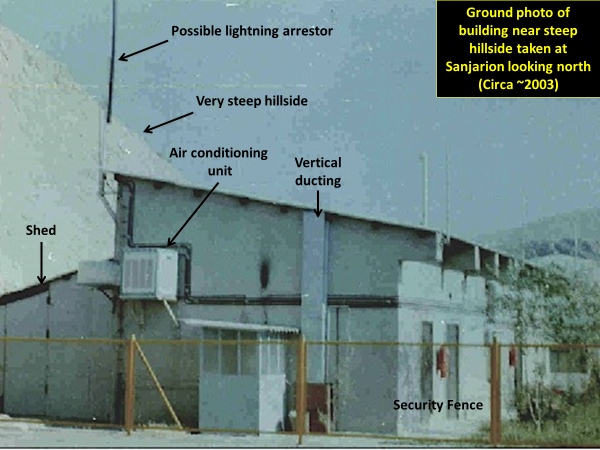
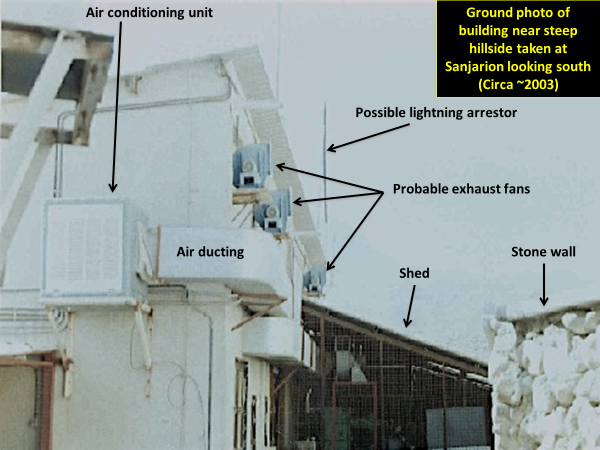
Figure 9. External photos from the archive of the Sanjarian site, also known as Sanjarion, the building housing activities for the Shock Generator Project. A lightning arrestor would be consistent with a building that handles high explosives.
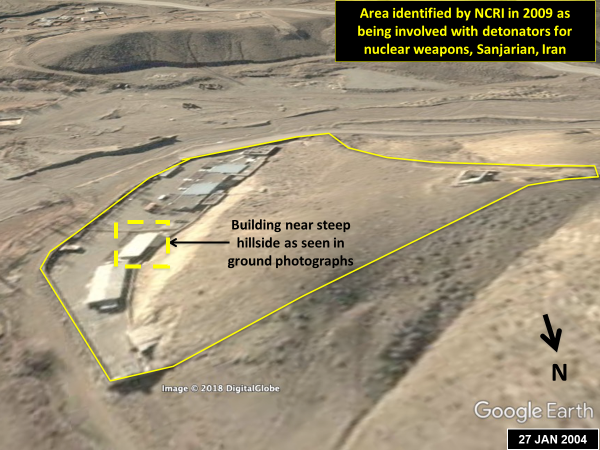
Figure 10. The complex of buildings that NCRI identified as METFAZ.
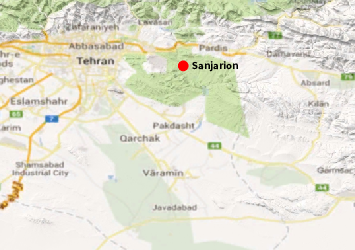
Figure 11. The Sanjarian site, also known as Sanjarion, relative to Tehran. The coordinates are 35.691 N 51.7000 E.
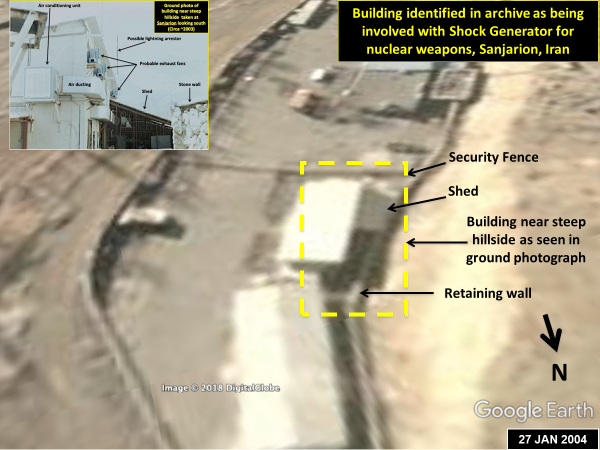
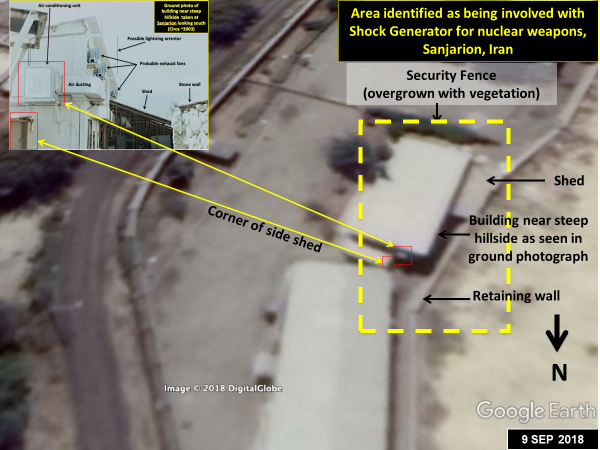
Figure 12. Correlations of the ground images to Google Earth images from 2004 and 2018.
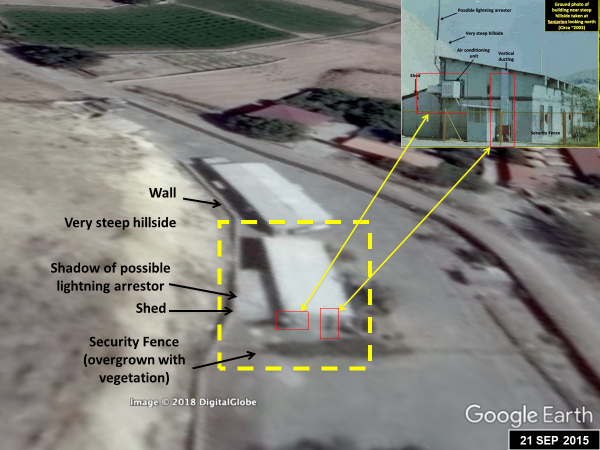
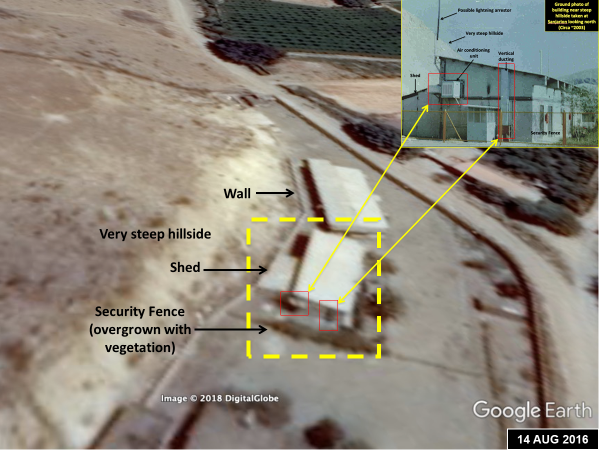
Figure 13. Additional correlations of the ground images to Google Earth imagery from 2015 and 2016.
PETN Manufacturing at Sanjarian
Based on the information in the archive, a critical function performed in the Sanjarian building was preparing pentaerythritol tetranitrate (or PETN) for use in the shock wave generator channels. As discussed above, the detonator functions by transmitting a detonation front via explosive in the channels to arrive simultaneously at a multitude of points on the shell. The explosive selected by Iran was PETN because, once mixed with a plasticizer, in this case polyisobutylene or PIB, it is easy to mold.
The building reportedly contained a manufacturing line for making sheets of plasticized PETN, although we could not verify this statement using geospatial analysis. The manufacturing process is straightforward and is illustrated by a series of photographs from the archive (see Figures 14-19). They show PETN powder, the manufacturing equipment, and the final sheets of plasticized PETN in storage:
- PETN powder
- Recrystallization reactor, e.g. recrystallized from acetone to give processable crystals
- Mixer, plastic binder (PIB) mixed with PETN
- Extruder, creating sausage shapes
- Roller, into flat sheets
- Storage of sheets
The sheets are then cut and inserted into the channels of the Shock Generator.
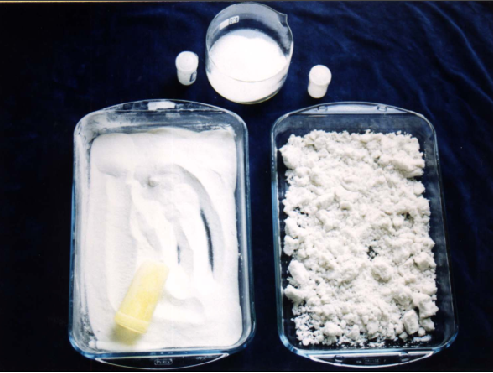
Figure 14. PETN powder image from the archive.
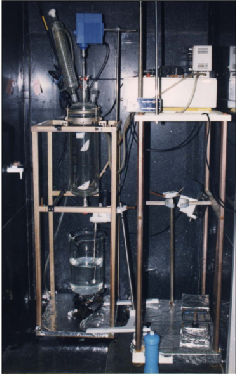
Figure 15. Recrystallization reactor image from the archive.
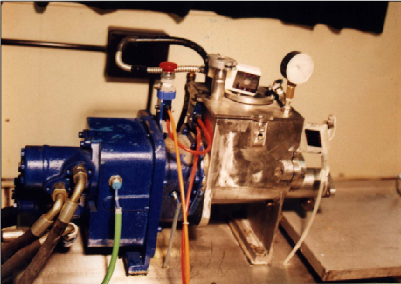
Figure 16. Mixer image from the archive.
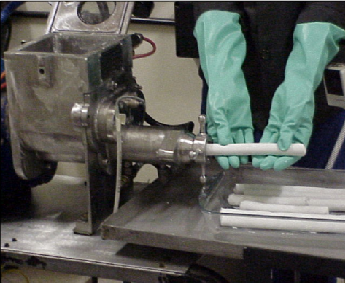
Figure 17. Extruder image from the archive.
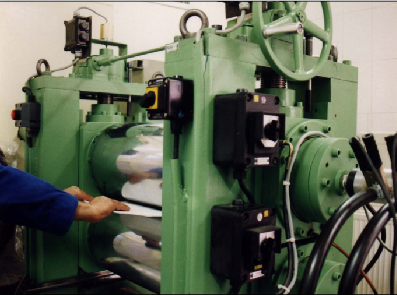
Figure 18. Hydraulic roller image from the archive.
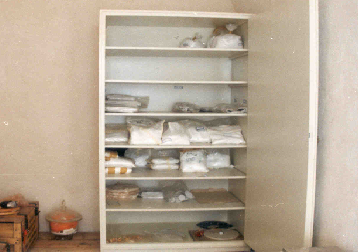
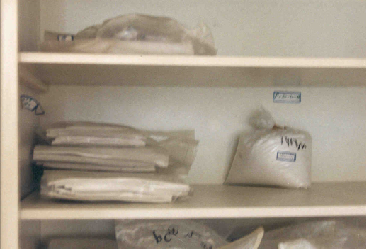
Figure 19. Plasticized PETN sheet storage, image from the archive.
Nour-Abad Blast Chambers
The Sanjarian building also reportedly held two blast chambers that were used to test EBWs, the shock wave generator or distributor, and other subcomponents possibly needed for the Shock Generator Project or related high speed diagnostic equipment. The blast chambers were called Upper and Lower Nour-Abad, where the lower one was smaller. Figure 20 shows two images from the archive of the Lower Nour-Abad chamber, where eight detonators or EBWs are visible. The Upper Nour-Abad chamber had a high speed camera that could take images of tests involving high explosives via a port on one side. This chamber is likely to have been only a few cubic meters in volume and able to handle a few kilograms of high explosives.
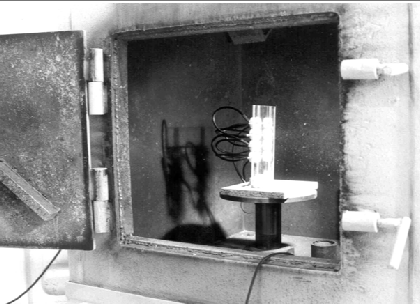
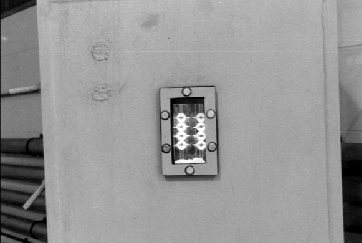
Figure 20. Two photographs from the archive of the Lower-Nour Abad blast chamber with eight EBWs or detonators visible.
The archive contained lists of tests conducted in the Upper and Lower Nour-Abad test chambers from October 23, 2002 until December 10, 2002 (Figures 21 and 22). The tests indicate that during this roughly two-month period, the shock wave generator was under development. Several tests are assessed as related to testing a smaller version than the one planned for use in a warhead that would be placed in a missile warhead.
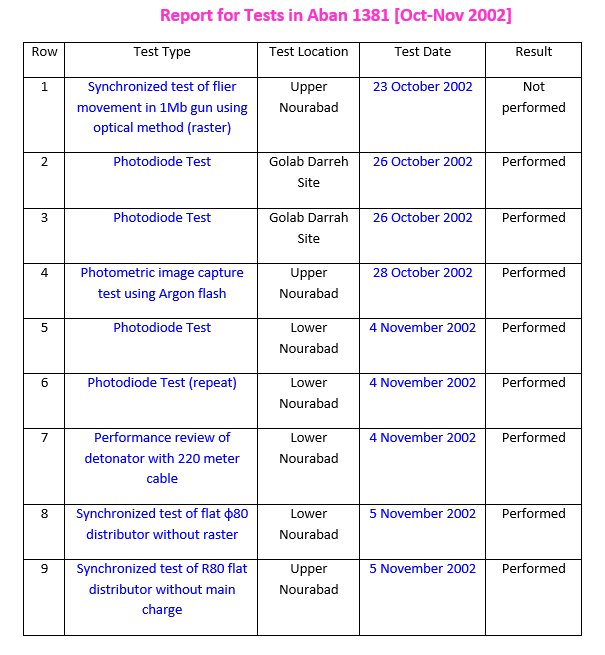
Figure 21. List of several tests in the Nour-Abad chambers during the Iranian month of Aban. Translated table from the archive.
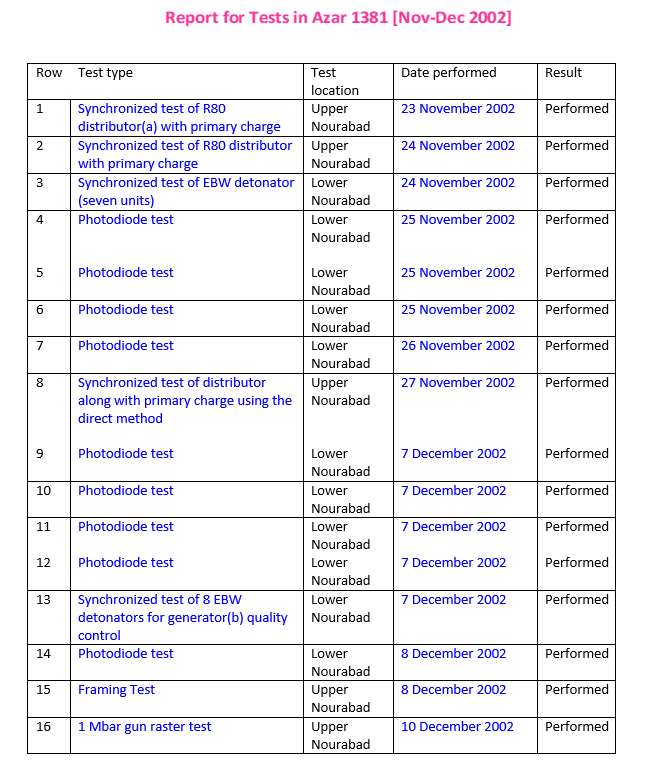
Figure 22. List of tests in the Nour-Abad chambers during the Iranian month of Azar. Translated table from archive. Comments of figure: (a) The Farsi word here is a transliteration of the English word distributor; (b) Here the Farsi word for generator is used. Similarly, the term “shock generator” in Farsi here and in other documents uses the Farsi word for generator.
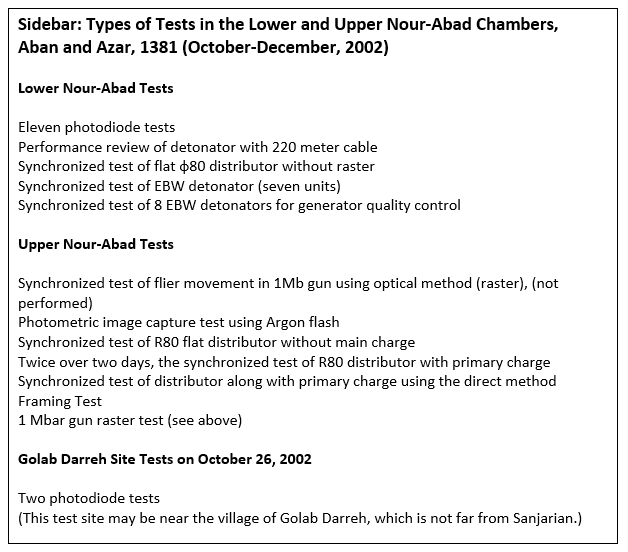
Photodiodes. As can be seen in the above Sidebar, photodiodes were tested 11 times in the Lower Nour-Abad chamber from November 4, 2002 to December 8, 2002. A photodiode converts a light signal to a current. Without more information, the purpose of these tests could not be ascertained. However, these tests may be related to developing fast diagnostic capabilities where light from an explosion is detected in a photodiode and subsequently recorded.
Detonators. EBW tests were performed involving the detonation of seven and eight units simultaneously. These tests of seven or eight EBW detonators stand in comparison to Iran’s declarations to the IAEA that it only tested two to three, although it did acknowledge firing EBWs in chambers.25
This information on tests of seven to eight EBW detonators appears to confirm information compiled by the IAEA. According to the 2015 IAEA report:
The development of safe, fast-acting detonators, and equipment suitable for firing the detonators, is an integral part of a programme to develop an implosion-type nuclear explosive device. Prior to November 2011, the Agency had information indicating that Iran, in 2002-2003, developed exploding bridgewire (EBW) detonators and a high voltage firing capability which, in combination, enabled several detonators to be fired with less than microsecond simultaneity.26
A detonator test with a 220-meter cable occurred, although the detonator was unspecified. It could have been either an EBW or a spark gap. This test could have been related to firing a nuclear device in an underground nuclear explosion for Project Midan, which required detonation at a distance.27
Shock Wave Generator. During these two months, a R80 distributor, another name for a shock wave generator, was tested three times, which could have been a scaled-down version of the one intended for a nuclear weapon (see earlier discussion of R265). Based on the discussion of the R265, this smaller hemispherical system would have an inner diameter of eight centimeters. Over the course of the two months, the tests of the generators appeared to move from simpler to more complex ones, where later ones involved the primary high explosive charge. The capacity of the Upper Nour-Abad chamber to contain high explosives is not known, although its capacity is believed to be far smaller than 50 kilograms, which was the amount of high explosive used in the 2003 test discussed earlier. Based on simply scaling volumes by radii, all other units such as the density of the main charge and thickness of the distributer being equal, the amount of high explosive needed in the R80 test would be expected to be less than five kilograms.
There was another test of an undefined distributor along with a primary charge. A flat “ф80” distributor without raster was also tested, but it is difficult to understand what this was. One can speculate that it was a flat distributor with a diameter of 80 millimeters, where the well-known engineering symbol for diameter, ø, is misspelled as the Greek letter “phi.” The use of raster in this case is difficult to discern, although it may refer to the diagnostic system (for example, see Figures 7 and 8).
The testing of these distributors in late 2002 is consistent with a large-scale, outdoor test at Marivan in 2003. This was discussed earlier.
Framing Camera. A “framing test” and “Photometric image capture test using Argon flash” may have referred to a test of a high speed camera critical to the types of efforts being performed in the chambers and elsewhere. The cryptic use of the phrase “framing test” may mean that this involved testing aspects of a high speed framing camera, which records a series of single images in a very short period of time. An argon flash is a single-use source of very short and extremely bright flashes of light, which Danilenko in his writings referred to in English as “explosive lighting.”28 Argon flash devices are almost exclusively used for photographing explosions and shock waves.29 Although krypton and xenon can be also used, argon is favorable because of its low cost. These tests could have been related to the fiber optic diagnostic system developed by Danilenko and his colleagues that was discussed above. In that system, explosive lighting with argon is used in some experiments so that every fiber optic cable in the diagnostic system is creating a line on the photographic film recorder, e.g. a raster.30 When the detonation wave reaches the fiber optic cable on the holder near the surface of the main charge, the source of additional light is cut off. In this way, the light from the detonation could be assigned to a specific fiber optic cable and subsequently more easily assessed.
“1 Mbar Gun.” The testing program used in these two months was bracketed by tests with a “1 Mbar gun” using an optical method (raster) in the Upper Nour-Abad chamber. The first, involving a synchronized test of flier movement, was not performed. The second did occur. It is unclear what was tested. If this Mbar gun refers to a relatively long gun for equation of state experiments and other shock experiments, the chamber is not understood to be long enough to hold the gun. The test may have involved understanding the time of arrival of the shock or detonation wave generated by the firing mechanism of the gun, based on the use of a diagnostic system similar to Danilenko et al.’s diagnostic method.
Post-Amad Reorientation Activities
The capabilities at Sanjarian were a unique asset, and quite sophisticated, and did not exist at other Iranian defense sites. Preserving these capabilities and the work force was a priority in the post-Amad reorientation plan. According to a 2003 archive document on reorienting and covering up various aspects of Amad, including this specific site, the Iranians decided to preserve both the capabilities, facility, and team associated with the shock wave generator project (see Sidebar: Reorientation Activities). The on-going activities would be provided with a cover purpose of performing non-nuclear military and non-military explosive tests:
The HMX and PETN projects should be operated by Malek-Ashtar University of Technology (MUT) or the Explosion Center. But regardless, the involved personnel should be used and their scattering prevented. To do so, the entire Sanjarioun site can be defined [translator’s note: or described] as ‘Center for research and modeling of military and non-military explosives (such as cladding).’ In this way, the medium explosion chamber is usable for execution of research of electric explosive tests.
The reference to cladding likely refers to a technique to use shaped charges to seal one metal to another through an explosively driven impact. Malek-Ashtar University is affiliated with Iran’s Defense Ministry and the Iran Revolutionary Guard Corps. This university was added in 2010 to the Specially Designated Nationals List of the Office of Foreign Assets Control, U.S. Treasury Department. That same year, it was also listed in UN Security Council Resolution 1929 and made subject to international sanctions.
The memorandum adds, “Of course, the matter needs to be decided, if the camera apertures should be blocked or kept open with the justification of possible application of it.” This last sentence could refer to concerns that if the aperture of the camera were visible to an outside party, such as the IAEA, it would signify that the chamber had conducted experiments that utilized a fast camera possibly related to nuclear weapons development.
There is little, if any, indication that the Sanjarian facility’s work related to nuclear weapons stopped. The Iranian decision appeared to be aimed at continuing the work under a civilian or non-nuclear military cover and possibly continuing difficult to hide, sensitive work in a covert manner.
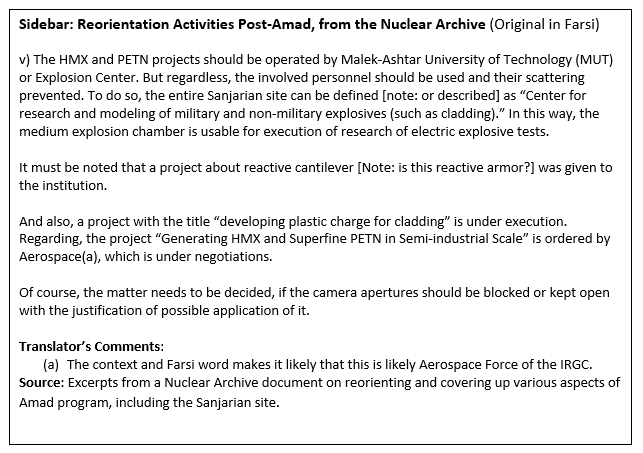
In 2011, the European Union (EU) sanctioned the Research Center for Explosion and Impact, aka METFAZ, and listed it as subordinate to Malek Ashtar University (MUT) and headed by Javad Al Yasin, whom the EU also designated.31 This organization appears to be the one identified by NCRI in 2009. This is the same Malek Ashtar University mentioned in the other post-Amad Plan reorientation information contained in the archive, suggesting that the transition of at least some of the Sanjarian activities to this university occurred, and could be sustained today.
In 2011, the IAEA published information about post-Amad Plan successor organizations, in particular the SADAT center, and listed one subgroup as the Center for R&D of Explosion and Shock.32 This could be the same as Sanjarian or METFAZ.
As mentioned earlier, in 2017, NCRI called the successor organization Center for Research and Expansion of Technologies for Explosion and Impact, aka METFAZ, which was part of Organization of Defensive Innovation and Research (SPND), the latest known incarnation of the reoriented Amad Plan. 33 NRCI said that the director of this unit was an engineer named Mohammad Ferdowsi, who had been working at the Defense Ministry since 1986 and is a high-explosive expert. At the same time, he was the chairman of the board of directors of the High-Explosive Society of Malek Ashtar University. However, as discussed above, NCRI stated that METFAZ in 2017 did not conduct these activities at Sanjarian, but conducted them at another, unknown location, which the NCRI identified as the “Research Academy” and claimed it was located in tunnels near the Mamlo Dam just north of the former Parchin High Explosive Test Chamber Facility. 34 The Institute could not corroborate the alleged activities at the Research Academy, although as mentioned earlier, the site at Parchin near the Mamlo Dam does contain a large, separately secured high explosives research, development, and manufacturing site.
The U.S. Treasury Department on March 22, 2019 sanctioned a range of organizations and individuals that are part of SPND, although it is difficult to relate the names of suborganizations in this designation list with earlier names of SPND subgroups. Nonetheless, the equivalent organization of METFAZ appears to be the Shahid Karimi Group that the U.S. Treasury Department stated worked on missile and explosive-related projects for SPND. Regarding sanctioned individuals associated with Shahid Karimi, the head of this group is Mohammad Reza Mehdipur, who has been involved in SPND explosion and shock research. Akbar Motallebizadeh was previously head of Shahid Karimi Group, where he supervised SPND projects. Akbar Motallebizadeh has also served as an advisor to Mohsen Fakhrizadeh, the head of SPND. Another member of Shahid Karimi, Jalal Emami Gharah Hajjlu, served as a senior expert and quality control manager for the Amad Plan. Sa’id Borji is an explosives and metals expert for SPND’s Shahid Karimi Group who has assisted SPND’s efforts to procure equipment used for containing explosions.
The U.S. government also recently designated Mansur Asgari, who has served as head of SPND’s Research and Technology Department. Mansur Asgari previously was a manager under the Amad Plan, overseeing projects focused on explosives and exploding bridge-wire (EBW) detonators. He is documented to have been involved in Project 3 deliberations in the Amad Plan. 35 In an alternative coding system used in the Amad Plan based on a numbering system, Project 3 included Project 110. (The Shock Generator Project was a subproject of 3.12, which was also called the implosion project. Other examples include Project 3.11, which was nuclear weapon design (Project Simulation), and Project 3.19, which was the underground testing project (Project Midan)).
Because of its importance, the work previously being done at Sanjarian may continue today under SPND or a follow-on organization. If so, it is important to ascertain where it is taking place and who is involved.
Findings and Recommendations
Although the Amad Plan did not reach its goal of building five nuclear weapons, it may have finished its effort to develop and build shock wave generators prior to the Amad Plan’s downsizing and reorientation. As such, a question is whether Iran possesses today partially or fully assembled hemispherical shock wave generators and the testing and manufacturing equipment necessary to make and maintain them. More specifically, does Iran stand ready, with necessary equipment and expertise, to make more shock wave generators for nuclear weapons?
The information in the archive confirms and adds to the IAEA’s assessments about a shock wave generator and that its testing occurred at Sanjarian. At least one such test was full-scale and conducted at the Marivan site in 2003.
The Nuclear Archive information adds new documentary and photographic information to the existing body of work about Iran’s nuclear weapons development and production efforts that was already understood prior to the seizure of the archive. The information in the archive confirms pre-existing information, fits with it, and expands upon it. The archive information stands as a solid refutation to Iran’s persistent denials that it never had a nuclear weapons program and provides substantial proof of its deceptions to the IAEA and the international community.
The archive raises again questions about how much sensitive information and expertise former members of Russia’s nuclear weapons program, including but not limited to Danilenko, may have passed to the Iranian nuclear weapons program prior to 2003.
The IAEA’s 2015 assessment that Iran had not moved beyond scientific and feasibility studies, and the acquisition of certain relevant technical competencies and capabilities related to nuclear weaponization, is now demonstrated to be incorrect. 36 The IAEA’s 2015 assessment is contradicted by the Nuclear Archive information on the work Iran performed on the shock wave generator, which included production activities.
The archive supports the assessment that work related to the shock wave generator continued after the Amad program. There are no credible indications that Iran discontinued the work conducted at the Sanjarian site in the early 2000s. Quite the reverse; Iran had reasons to maintain this unique, critical nuclear weapons capability – if not at Sanjarian, then at another, alternative location. This work could be both clandestine and overt, with the latter carried out at a university or research institute under a plausible, but deceptive, civilian or non-nuclear, military cover.
The IAEA needs to inspect the Sanjarian site and related facilities, examine relevant equipment and materials, and interview the personnel mentioned in the archive and the IAEA’s previous, extensive documentation related to the shock wave generator project, alternatively called the MPI system. It needs to characterize the status of the program today, its work and associated equipment, and interview any related personnel.
As we have recommended throughout this effort to comprehensively understand the Iranian Nuclear Archive, the new information derived from it adds more urgency to efforts to: create a full, correct and complete history of Iran’s nuclear weapons efforts; obtain answers from Iran about the fate of the equipment, material, technology, and personnel discussed in the archive; and more broadly, to characterize the Amad Plan and its successor programs.
Iran may have had, and still may have until now, undeclared nuclear materials and facilities – a finding the IAEA reiterates every three months in its quarterly reports on the Iran nuclear deal. It is therefore essential that the IAEA Board of Governors requests the Secretariat to verify in a timely manner the existence of the documents in the archive, their contents, and related equipment to ensure that all nuclear material and activities have indeed been declared to the IAEA, and all non-peaceful activities have been terminated and relevant capabilities dismantled.
The IAEA should be asked to verify sites, locations, facilities, documentation, equipment, and materials mentioned in the archive; question personnel involved; and report on that work. Iran should be urged to cooperate fully in these investigations. In particular, no information or equipment should be destroyed, and no locations altered before the IAEA has completed its investigations. Those IAEA investigations should include weapons experts with proper clearances. It is essential that the IAEA Secretariat reflects in its quarterly reports on Iran the progress made so that the Board of Governors can exercise its oversight function.
At the end of the inspection process, proliferation-sensitive information and equipment, where possession is not in line with Iran’s undertakings under Article II of the NPT, should be verifiably and irretrievably destroyed or removed from Iran in a verifiable manner.
** Olli Heinonen is Former Deputy Director General of the IAEA and head of its Department of Safeguards. He is a Senior Advisor on Science and Nonproliferation at the Foundation for Defense of Democracies.
1. In previous Institute reports, the shock wave generator was translated as a detonation distributor. It is also just called a distributor. ↩
2. The Sanjarian site was first made public by the MEK/NCRI in 2009. See below and: James Mackenzie, “Exiled group says Iran working on nuclear triggers,” Reuters, September 24, 2009, https://www.reuters.com/article/idINIndia-42681020090924. That reporting also referred to the Sanjarian site as the METFAZ site. ↩
3. David Albright, Sarah Burkhard, Olli Heinonen, Frank Pabian, and Andrea Stricker, “Project Midan: Developing and Building an Underground Nuclear Test Site in Iran,” Institute for Science and International Security/Foundation for Defense of Democracies, April 2, 2019, http://isis-online.org/isis-reports/detail/project-midan-developing-and-building-an-underground-nuclear-test-site-in-i/8 ↩
4. Although the 2002 HMX manufacturer is not identified in the slides, later information is consistent with it being used in military industries. In 2016, the Defense Industries Organization of the Iranian Defense Ministry inaugurated a new facility to mass produce HMX (also called Octogen). For example, see: “Iran made Octogen Explosive (HMX) substance production, Youtube, April 6, 2016, https://www.youtube.com/watch?v=e7R5EttGICQ ↩
5. “Excerpts from Internal IAEA Document on Alleged Iranian Nuclear Weaponization,” _Institute for Science and International Security, October 2, 2009, http://isis-online.org/uploads/isis-reports/documents/IAEA_info_3October2009.pdf ↩
6. IAEA Director General, “Final Assessment on Past and Present Outstanding Issues regarding Iran’s Nuclear Programme,” GOV/2015/68, December 2, 2015, https://www.iaea.org/sites/default/files/gov-2015-68.pdf ↩
Due to space limitations, the footnotes continue in the pdf.

 twitter
twitter